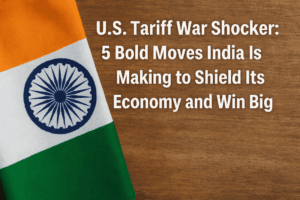U.S. Tariff War Shocker: 5 Bold Moves India Is Making to Shield Its Economy and Win Big
India’s Strategic Response to U.S. Tariff Pressures Facing renewed U.S. tariffs under Trump’s administration, India navigates a precarious trade landscape marked by its reliance on the U.S. (17% of exports) and China (15% of imports). Key sectors like steel, pharmaceuticals, and textiles risk disruption from levies, threatening jobs and export revenues. However, India is countering with trade diversification—deepening EU and ASEAN ties—and boosting domestic manufacturing via production-linked incentives (PLI), notably in electronics and EVs.
Negotiations aim to balance U.S. demands for market access with India’s push to restore preferential trade terms. While short-term volatility looms for export-driven industries, long-term opportunities emerge in green energy, defense, and tech self-reliance. Strategic diplomacy, coupled with a focus on rupee-based trade and a growing domestic consumer base, positions India to mitigate risks and leverage global shifts.
Investors must weigh sectoral risks against India’s structural reforms and $1 trillion digital economy vision, signaling resilience in a fragmenting world order.

U.S. Tariff War Shocker: 5 Bold Moves India Is Making to Shield Its Economy and Win Big
The resurgence of U.S. tariff policies under Donald Trump’s administration has reignited global trade tensions, with India finding itself at a critical juncture. As the U.S. imposes steep levies on imports from 60 nations—including a temporary reprieve for India until July—the ripple effects threaten to disrupt supply chains, inflate costs, and reshape economic alliances. Here’s an in-depth analysis of how India is maneuvering through this turbulence and what lies ahead for its economy and investors.
India’s Trade Ecosystem: Partners and Vulnerabilities
India’s economy, deeply integrated into global trade, relies on a network of key partners:
- Top Import Sources (2023-24):
- China (15%): Electronics, machinery, pharmaceuticals.
- U.S. (8%): Oil, aerospace tech, almonds.
- UAE (7%): Crude oil, gold.
- Leading Export Destinations:
- U.S. (17%): Refined petroleum, diamonds, pharmaceuticals.
- UAE (6%): Gems, textiles.
- China (5%): Iron ore, organic chemicals.
Insight: While the U.S. remains India’s largest export market, dependence on Chinese imports for critical components exposes vulnerabilities. Recent efforts to diversify imports—such as boosting semiconductor ties with Japan and Taiwan—aim to reduce this reliance.
U.S.-India Trade: A Delicate Balancing Act
Bilateral trade hit $128 billion in FY23, with India enjoying a $28 billion surplus. However, friction points persist:
- Tariff Disparities:
- India’s agricultural tariffs (37.7%) far exceed U.S. rates (5.3%), complicating negotiations.
- U.S. steel tariffs (25%) threaten India’s $1.3 billion steel exports.
- Historical Flashpoints: The 2019 revocation of India’s GSP status, impacting $5.6 billion in exports, underscores the fragility of trade ties.
Strategic Shift: India is leveraging its consumer market potential—6% of U.S. apple imports now come from India—to negotiate favorable terms. Meanwhile, the U.S. seeks greater access for dairy and medical devices.
Sectoral Shockwaves: Who Bears the Brunt?
- Steel & Auto: Tariffs on Indian steel (4.5% vs. U.S. 2%) could squeeze margins for Tata Steel and JSW Steel. Auto giants like Maruti Suzuki face rising input costs.
- Pharmaceuticals: U.S. scrutiny on generic drug pricing and quality compliance (e.g., Sun Pharma’s FDA warnings) adds pressure.
- Textiles: With $12 billion in U.S. exports, tariffs risk 2 million jobs in hubs like Tiruppur.
- Agriculture: Soybean and almond imports from the U.S. face retaliatory tariffs, impacting Indian food processors.
Silver Lining: The PLI scheme has spurred $55 billion in electronics production, cushioning the blow for manufacturers like Dixon Technologies.
India’s Counterplay: Diversify, Innovate, Negotiate
- Trade Diversification:
- EU FTA Talks: Aimed at boosting textile and tech exports.
- Rupee Trade Agreements: With UAE and Russia to bypass dollar volatility.
- Domestic Push: PLI schemes target 14 sectors, with smartphones (exports up 75% in 2023) and EVs (Tata Motors’ 72% market share) leading the charge.
- Diplomatic Negotiations: India’s offer to reduce Harley-Davidson tariffs from 50% to 25% signals flexibility, while demanding restored GSP benefits.
Expert Take: “India’s focus on self-reliance isn’t isolationist—it’s about creating leverage in trade talks,” says Arvind Subramanian, former Chief Economic Adviser.
Investor Outlook: Risk, Resilience, and Opportunity
- Short-Term Caution: Export-heavy sectors (IT, pharma) face earnings volatility. The Nifty 50’s 8% drop post-tariff announcements reflects market jitters.
- Long-Term Bets:
- EVs & Renewables: Companies like Ola Electric and ReNew Power benefit from green incentives.
- Defense: ‘Make in India’ drives growth for HAL and Bharat Forge.
- Manufacturing: Foxconn’s $1.5 billion Karnataka plant highlights PLI-driven FDI.
Advisory: “Investors should balance defensive stocks (FMCG) with growth sectors (infrastructure, tech),” recommends Nilesh Shah of Kotak Mahindra AMC.
The Road Ahead: Geopolitics and Globalization 2.0
India’s ability to navigate the tariff war hinges on three factors:
- Multilateral Alliances: Strengthening BRICS and ASEAN ties to counterbalance U.S.-China dominance.
- Digital Pivot: Expanding IT services and digital exports (targeting $1 trillion by 2030) to offset manufacturing dips.
- Domestic Consumption: A burgeoning middle class could absorb $500 billion in annual production by 2030, insulating the economy.
Final Word: While tariffs pose immediate challenges, India’s hybrid strategy—mixing negotiation with self-reliance—positions it to emerge as a resilient player in the recalibrating global order. The next 90 days will test diplomacy, but the long game favors structural reform and strategic diversification.
You must be logged in to post a comment.